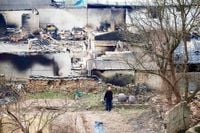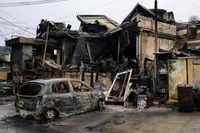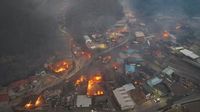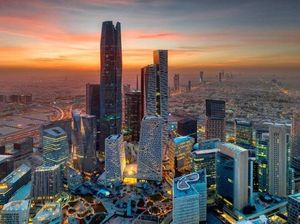South Korean police have arrested a 56-year-old man suspected of igniting the country’s worst wildfires in history, which have devastated large swathes of the southeastern region. The man is accused of starting the fire on March 22 while performing an ancestral ritual at his family’s grave in Uiseong County, North Gyeongsang Province. This tragic incident has resulted in the deaths of at least 30 people and the destruction of approximately 48,000 hectares of forest, equivalent to 80 percent of Seoul's area.
The fire began around 11:25 a.m. when the man was reportedly cleaning the graves of his ancestors and burning leftover rubbish. As he attempted to ignite tree branches above the grave with a cigarette lighter, the flames were quickly fanned by strong winds and dry conditions, leading to a catastrophic wildfire that spread to nearby areas, including Andong, Cheongsong, Yeongyang, and Yeongdeok.
According to the police, the suspect has denied all charges against him, but his daughter provided a statement to investigators indicating that her father’s actions inadvertently sparked the blaze. “The flames were carried by the wind and ended up sparking a wildfire,” she was quoted as saying by Yonhap news agency.
The fires have wreaked havoc across the region, leading to the destruction of around 4,000 buildings, including the historic Goun Temple, a UNESCO World Heritage site believed to have been built in the 7th century. The scale of the disaster has been unprecedented in South Korea’s history, with the forestry agency confirming that the forest fire is the worst ever recorded in the country.
As emergency responders worked tirelessly to combat the flames, the South Korean Forestry Service announced that the fire had been largely contained by Friday evening. However, it flared up again on Saturday night, prompting authorities to deploy significant resources to tackle the ongoing threat. By Sunday morning, officials reported that the fire was 99 percent extinguished, but a 200-meter-long fire near Mount Jiri National Park was still being monitored.
Emergency services mobilized a staggering 50 helicopters, 1,473 personnel, and 213 vehicles to combat the wildfires, which were exacerbated by months of below-average rainfall and extreme dry conditions following South Korea’s hottest year on record in 2024. Among the 30 fatalities was a helicopter pilot who tragically died when his aircraft crashed while battling the flames.
The situation has drawn attention not only for its immediate devastation but also for highlighting South Korea's demographic crisis. Many rural areas, particularly those affected by the fires, are underpopulated and largely inhabited by the elderly, raising concerns about the resilience of these communities in the face of such disasters.
In addition to the human toll, the wildfires have caused significant damage to cultural heritage sites. Reports indicate that at least 18 designated heritage sites or objects have been affected, prompting the Korea Heritage Service to deploy 750 personnel to assess and catalogue the damage.
As the investigation into the cause of the fire continues, police plan to conduct a joint inquiry with the National Forestry Science Institute, the National Forensic Service, and fire authorities. The suspect, who has been booked without detention, will be questioned further once the on-site inspections are complete, which could take over a month.
Authorities have not only focused on extinguishing the fires but are also preparing for potential future outbreaks. The highest fire warning level remains in effect nationwide, and additional resources are being allocated to prevent similar incidents. On Sunday, another wildfire broke out near Suncheonsi, prompting the deployment of 23 fire trucks, four helicopters, and 123 firefighters to tackle the new blaze.
The devastating impact of these wildfires has sparked discussions about climate change and its role in increasing the frequency and intensity of natural disasters. Experts have noted that the extreme weather conditions contributing to the wildfires may be linked to broader environmental changes.
As the nation begins to recover from this tragedy, the stories of loss and resilience continue to emerge. The South Korean government is expected to implement measures aimed at both immediate recovery and long-term prevention strategies to safeguard against future disasters.
The wildfires in South Korea serve as a stark reminder of the fragility of life and the environment, as communities come together to mourn their losses and rebuild their lives in the wake of destruction.






